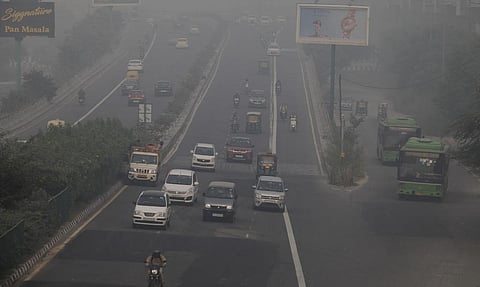

It is not just particulate matter (PM) that has been high across north India in the first smog episode of this winter season. The levels of toxic gases like ozone and carbon monoxide have also breached safe limits, according to an analysis by Delhi-based non-profit Centre for Science and Environment (CSE).
Ozone levels have broken records at ozone hotspots in Delhi, according to a statement by CSE. Carbon monoxide (CO) has also exceeded average levels.
Sulphur dioxide (SO2) levels have mimicked the trend of PM2.5 but have not breached the standard.
Avikal Somvanshi, programme manager and expert at CSE’s Sustainable Cities Programme, said:
While very high concentrations of PM2.5 have hogged attention, the levels of gases — ozone, CO or nitrogen dioxide (NO2) — have remained elevated during this smog episode. Also, the ratio of SO2 to NO2 increased on Diwali night indicating increased pollution load from firecrackers. The PM2.5 concentration on Diwali night (8 pm-8 am) has been the most intense since 2017.
Another important finding of the analysis is that on an average, the contribution of smoke to Delhi’s daily PM2.5 during the middle of October to November 8 has been the lowest in the last four years.
Smoke from stubble fires has contributed to 12 per cent of Delhi’s daily PM2.5 this year. This is in contrast to 17 per cent per day in 2020, 14 per cent per day in 2019, and 16 per cent per day in 2018.
If converted to absolute concentrations, the per day contribution of smoke stood at 26 microgram per cubic metre (µg / m³ ) this year so far compared to 35 µg / m³ in 2020, 40 µg / m³ in 2019, and 31 µg / m³ in 2018.
The peak contribution of smoke to Delhi’s PM level was recorded November 7, when it reached 48 per cent. This is the second-highest daily contribution percentage recorded since such an estimation was started by the Union Ministry of Earth Science’s System of Air Quality and Weather Forecasting and Research (SAFAR).
The first smog episode of 2021 has so far lasted for six days, similar in duration to the first smog of the 2018 and 2020 season. The first smog episode of 2021 might overtake the 2019 smog that lasted eight days, according to CSE.
It attributed the lingering on of this year’s smog for a longer duration despite relatively windier local conditions to the lack of pollution control measures in Delhi.
Anumita Roychowdhury, executive director, research and advocacy, CSE, described the ongoing smog episode as a ‘public health emergency’.
“This requires urgent emergency action on key combustion sources (vehicles, industry, waste burning) and dust sources (construction and roads) to prevent further trapping of pollution when there is no wind to blow this away. We need pollution-source-wise and hotspot-wise status of action,” she said.